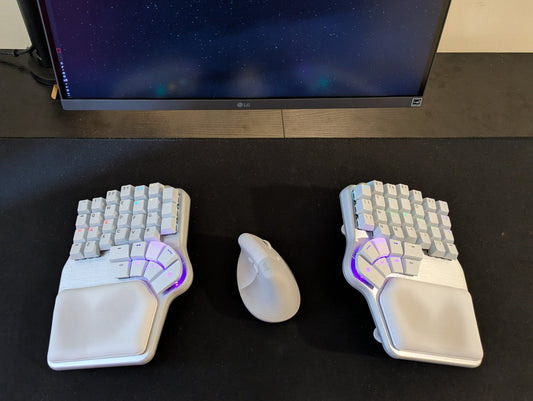TLDR: There's no chance a regular keyboard is ergonomic. No matter what they tell you.
If you think about what makes a keyboard ergonomic, the answer is simple: Something is ergonomic as long as it helps the user with the task at hand while keeping him healthy and safe.
If you consider a keyboard, then the least you could expect from an ergonomic keyboard is not experiencing pain after a couple of hours of typing.
The pioneers of ergonomics
Ever since the typewriter was invented over a century ago, there have been issues associated with its use.
Luckily, several attempts to tackle them have been made through the years.
The first one dates back to 1926, by Dr. Klockenberg, but the one that interests us the most is an essay published by Dr. Kromer in 1972, "Human engineering the keyboard", where he figured out which was the optimal position for a typist.
It's this one:

Kroemer's study set the standard for today's optimal typing position. Notice that the typist is sitting with her back straight and looking at the screen without having to stretch her neck in any way. But most of all: look at her hands. Yes! That's a split keyboard. But let's not get ahead of ourselves.
Unfortunately, these studies did not make a great impact on the way keyboards were designed. Companies didn't like the idea of having to replace all their keyboards and retrain their staff. So they just let it slide, and the computer boom of the '80s and '90s came along with keyboards based on the old QWERTY typewriters.
Trapped in the typing machine
So here we are, stuck with keyboards whose design is based on an invention from 1868.
It's not that the typing machine was not a great design, but nowadays, conventional keyboards are an ergonomic nightmare. Here's why:
Look at your hand on your keyboard. Notice how they are one next to the other? That's not a natural position; to reach it, your wrists have to bend outwards, stretching your tendons and muscles of your forearm. Maybe it doesn't seem like a big deal, but the pain you feel in your forearm after a few hours of typing comes from that hand position.

But the issues with your posture don't stop there. Now, look at your elbows. Do you see how close to the body they are when you're typing? And that's not the main problem: if you take a glance at your shoulders, you'll notice that they are leaning forward, towards the table. Overall, this makes it very complicated to keep your back straight, so you end up slouching.
When we feel pain in the back, we start worrying about our posture, how we can improve it, the best exercises to avoid it, etc... But it's too late. We tend to focus on the pain itself and not on the cause: Your very uncomfortable hand position.
¿The solution? Split the keyboard
So far, we've proven that conventional keyboards can not be ergonomic in any way, shape, or form. Let's move on and prove why ergonomic keyboards are split, shall we?
Thanks to their design, these keyboards conform to the natural position of your hands. You don't longer have to keep them together like a praying mantis.

But there's more. Thanks to the more natural position, your hands no longer push your elbows towards your body. Now you can open your chest and shoulders, and having your back straight is no longer a problem.
There's a wide consensus in the fact that conventional keyboards can be harmful to their users. Neither there's a doubt in the fact that split keyboards greatly reduce the impact of upper-extremity work-related musculoskeletal disorders.
Split keyboards enhance the user's posture, reducing problems associated with slouching, such as neck pain and headaches, and wrist extensions, like carpal tunnel syndrome or ulnar deviation.
Ok, an ergonomic split keyboard is good. But is it for me?
Many people might think that getting used to a split ergonomic keyboard is a tortuous process and that you can lose your ability to type at your usual speed for a long time. Well, it's not that hard, but it's not instant either.
Touch typists adapt almost immediately, but some other people might take longer. Nevertheless, it will only mean you'll type a little bit slower for a couple of weeks. In no time, you'll be back to your usual WPM.
Then why aren't all ergonomic keyboards split?
Split ergonomic keyboards are the future; there's no question about it. The growing use of computers will create a huge demand for them; because the pain, discomfort, and injuries associated with the conventional keyboard are not going anywhere.

Besides, solutions for improved ergonomics, like tenting, can only be applied to split keyboards, so regular keyboards are getting even further behind.
However, not all of the so-called ergonomic keyboards are split. They might have a split layout, like the Microsoft Sculpt or the Logitech Erto K860, but you're stuck with that distance between both sides.

So, if you finally go for an ergonomic keyboard, make sure it's split. It'll be easier for you to find the best position for your hands, feeling much more comfortable in the long run.
Plus, split ergonomic keyboards also offer extra perks, like palm support or thumbkeys and fully customizable layouts and layers that will help you reduce your hand movement and finger stretching.









